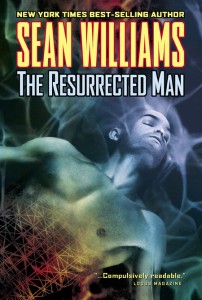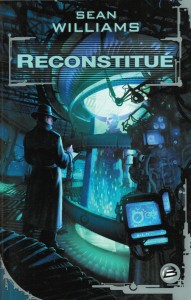Resurrecting The Resurrected Man
 Once upon a time, I wrote a novel about d-mat. I’m not talking about Twinmaker. This was a crime thriller set in the future, concerning a cop whose ex-BF is the main suspect in a series of nasty murders. Someone has hacked the network to create copies of people. When the copies are killed, the originals are left alive – so is that legally murder or what? The fact that all the murdered people look just like her only adds to the ick.
Once upon a time, I wrote a novel about d-mat. I’m not talking about Twinmaker. This was a crime thriller set in the future, concerning a cop whose ex-BF is the main suspect in a series of nasty murders. Someone has hacked the network to create copies of people. When the copies are killed, the originals are left alive – so is that legally murder or what? The fact that all the murdered people look just like her only adds to the ick.
Things become even more complicated when her ex is finally found, and it turns out he’s been in some kind of self-induced coma for years, which is about the best alibi you can have. But what if he copied himself, and it’s the copy who’s committing the murders? Is this version of him guilty or not?
Twists and turns ensue.
The Resurrected Man was my second novel. I wrote it not long after my dad died, hence the father-son issues all the way through it (my best friend’s mother only ever calls it “that book about your father”). It’s big and complicated and (I’m told) unputdownable. And if you squint really hard you can pretend it’s in the same universe as Twinmaker, in that d-mat, WHOLE, and Qualia are name-checked.
It might therefore tide you over if you’re looking for something to plug the gap before Crashland (aka Crash) lands. But be warned! It’s an adult novel, and therefore contains body parts.
Here are some blurbs:
“When matter transmission booths are finally invented, no doubt certain children will instinctively fear stepping into them. The Resurrected Man magically prefigures those childhood terrors of tomorrow, resulting in a police procedural that is unblinking, noirish, and gnawingly compelling.” (Scott Westerfeld)
 “Sean Williams is one of the brightest new generation Aussie SF stars. The Resurrected Man pushes cyberpunk’s envelope, then licks its stamp.” (Damien Broderick)
“Sean Williams is one of the brightest new generation Aussie SF stars. The Resurrected Man pushes cyberpunk’s envelope, then licks its stamp.” (Damien Broderick)
And here’s an excerpt from my PhD thesis, in which I discuss the novel:
‘Crime fiction, like science fiction, is fundamentally concerned with the notion of identity. Just as the movie Bladerunner “extends Chandler’s ‘separation of people from each other’ into the distance between planets”, requiring the detective to bring them together, The Resurrected Man casts even the identity of the detective into question while at the same time using spatial collapse to unite characters in conflict (Bukatman 143). The effects of spatial collapse can also be seen in a global polyglot culture, featuring a gutter patois gleaned from numerous disparate languages. The events of the novel take place across the Earth and beyond with equal convenience. The only car chase, a traditional staple of crime fiction, takes place in Quebec, an independent nation that spurns d-mat and harbours a militant reactionary organisation called WHOLE, whose members believe that d-mat results in the destruction of the soul. Quebec is the last isolated country remaining in the world, with access granted only by old-fashioned airports and border checkpoints—what is normal to us rendered alien in the fictional world of the novel.’
Still awake? The book is much more exciting than my thesis, honest!
PS. No, that’s not me on the US cover.
